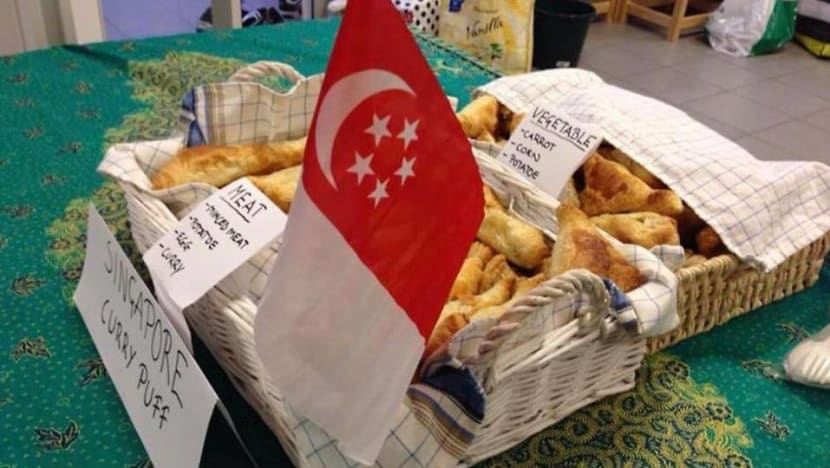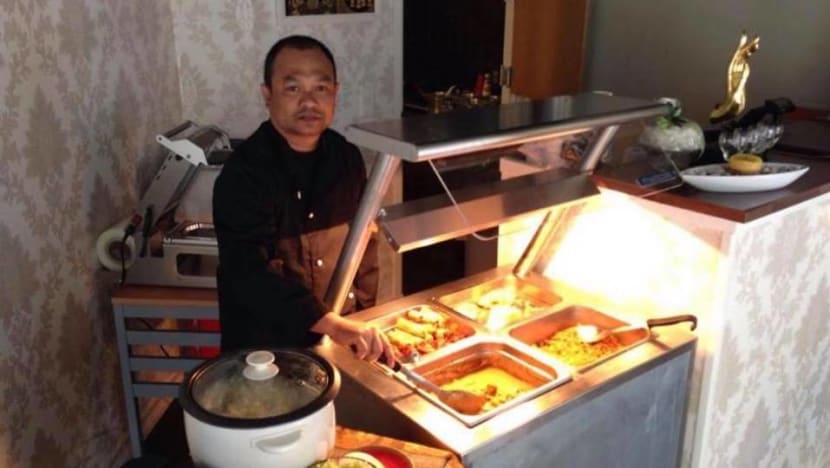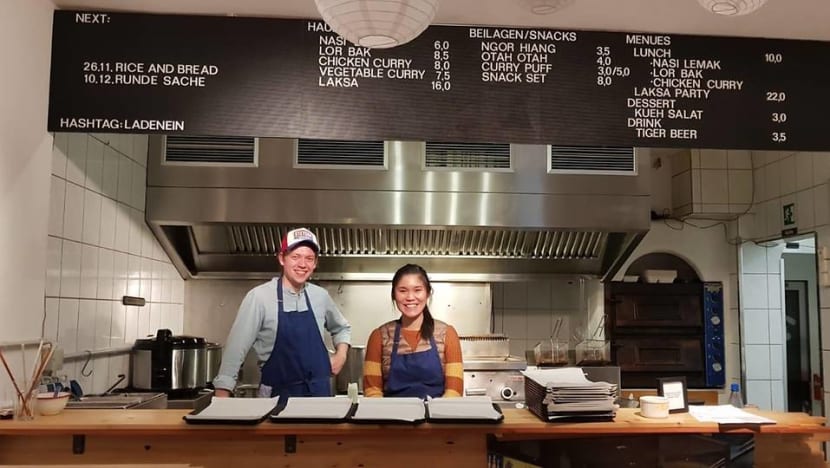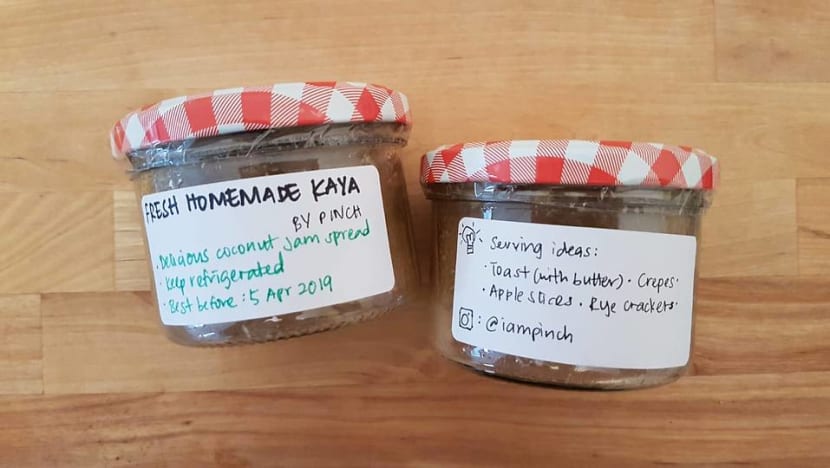A taste of home: The expat Singaporeans cooking up a storm to feed foreigners with authentic dishes
Step aside, Singapore Noodles. Some overseas Singaporeans are on a mission to introduce authentic local cuisine to their host countries.

Curry puffs made and sold by Jasni Zakaria in Finland. (Photo: Jasni Zakaria)
SINGAPORE: For some Singaporeans living abroad, the thing they miss most isn't family or friends.
It's food.
No matter how hard they look, they can't find anywhere that serves chicken rice or char kway teow with the authentic, cooked-in-a-heartlands-coffee-shop Singapore taste.
For 52-year-old Jasni Zakaria, it started when he was frustrated with the food options available in Finland where he has been living for the last 23 years. He resides in Jyväskylä, about four hours away from Helsinki.
“In Finland, it’s very difficult to get Asian food and they sell Chinese and Indian food but it’s not original,” said Jasni.
According to him, fried rice would often be too oily and curries would come from pre-packaged jars. It is also not spicy enough for his Singaporean taste buds.
“I cannot get the real taste. … I don’t care about the price, I just want good food that I cannot get!” he added.

The self-professed foodie said that he has been searching all over Finland for authentic Asian food. There are only a handful of restaurants that have been able to give him what he is looking for in capital Helsinki and Oulu.
His desperation led him to cook for himself, and this eventually led him to start selling his offerings.
“I made curry puffs for my work friends to try. They liked it so I turned it into a business. I also made fried rice but it’s the Malay way; the fried rice that my father used to make,” said Jasni, whose full-time job is assembling hydraulic cylinders.
He sold them by standing outside hotels, pubs and outside football matches. Curry puffs usually go for between €1 (S$1.52) to €2.50 each, while a serving of his fried rice is priced at €3 to €5.
He has also sold his food at food festivals, and most of his customers are local Finns.
“One night, I can earn about €1,200 from selling fried rice. After paying for the ingredients and the place to cook, I still make about €1,000 a night,” Jasni said.
GERMANY
For Singaporean Angie Tan and German Fabian Böddecker, both 33, getting into the F&B industry was always a dream. Without culinary backgrounds, both of them would experiment with recipes and post them on their food blog called riceandbread.
After going to a supper club in Cuba in 2016, Angie and Fabian wanted to replicate the experience but with Southeast Asian food served communally. They started hosting private three-course dinners at their home in Düsseldorf last year.
“There also wasn’t any other place that offered Singaporean food. The closest we could find was Malaysian food but they were also under the disguise of a Chinese restaurant in Düsseldorf. We thought it would also be really interesting to see how people would react to Singaporean food as well,” Angie added.

From there, the couple started tackling food festivals and pop-up restaurants.
For two weeks at a pop-up restaurant in November last year, they served curry puffs, ngor hiang and otak-otak as snacks, as well as nasi lemak, lor bak, curry chicken and laksa as main dishes. There was even kueh salat for dessert.
“We didn’t have family recipes so I was basically collecting them from the Internet, testing it out and coming up with our own recipes. These are recipes that we’ve used to cook for our friends and supper clubs,” Angie said.
The response from their customers was “overwhelmingly positive” but some dishes sold better than others.
“What was a bit difficult was to get people to order something else other than curry.”
“For Germans, chicken curry is something they can process and understand what it is. But having them to order something else like laksa or nasi lemak is actually not as easy as we thought but the people who tried it liked it,” Fabian said.

But even so, Fabian and Angie have not tried to localise the dishes to suit the German taste buds. Dishes like their chicken curry or laksa are served spicy in general but when customers tell them that it’s too spicy, they will add a little coconut milk to make the dish more palatable.
To make these dishes, they have had to do significant research on where to source their ingredients. For example, laksa is a challenging dish to replicate in Germany because of the lack of availability of dried shrimps and the correct noodles.
“Dried shrimps are very, very difficult to come by. If you make laksa paste, you need dried shrimps for it. A hundred grams over here costs €8. So that makes cooking with it very expensive. What we struggled with too at the beginning was laksa noodles because the laksa noodles that we know is a Singaporean brand and there is only one place that we know that we can buy from in the Netherlands,” Fabian said.
The other ingredients are easily available in Düsseldorf because of its large Asian community.
Another German resident, Tang Pin-Ji, 33, sells kaya from her home in Berlin. Owing to an abundance of Asian supermarkets in Berlin, she is able to get fresh pandan leaves for her kaya.
Pin-Ji started making kaya to bring them to house parties and office parties to share a piece of home with her friends and colleagues 1.5 years ago.

It was only late last year that she started getting her first paid orders, with those who have tried her kaya wanting to share it with their friends. Half of her customers are Singaporeans and Malaysians while the other half are Germans and other Europeans.
“They find it delicious and the feedback has been positive so far, although for very different reasons. For the Singaporeans and Malaysians, it’s a feeling of nostalgia. For the Germans and Europeans, it’s either a novelty or it’s because they’d tried it on holiday in Singapore or Malaysia,” Pin-Ji said.
“I generally feel that Singaporean food is severely underrepresented in a global city like Berlin and many locals can't tell the differences between Asian cuisines. You could say that making kaya is my way of telling them this is where I'm from and this is what people back home love,” she added.
UNITED STATES
Faridah Zee Jusuf, 57, who goes by Zee, moved to the United States in 2002 and went into the food business in 2017 after retiring from the real estate industry. She started Zippy Zee Kitchen as she moved into semi-retirement and can be found at pop-up events or farmer’s markets all over Florida.
“Nasi Lemak sells because everybody here loves coconut. They like spicy food like buffalo wings. Coconut rice and chicken rendang always sells,” Zee said.

To make Singaporean food more accessible to Americans, she has even created her own version of a burrito - a rendang wrap - that is made with shredded beef rendang and roti prata as a wrap.
According to her, she is the only one selling Singaporean food in Florida. But wherever it is in the US, it is hard to find Singapore fare.
“Not even in Los Angeles. There are a lot of Malaysian places. It’s not so different from Singaporean food but I think our food is better than theirs,” Zee joked.
To make her food, she has to search high and low to find the right ingredients.
Zee returns to Singapore two times every year and on those trips, she packs over up to 70kg of ingredients to bring back to Florida. It includes kerisik, ikan bilis, and a frozen chilli paste that she makes in Singapore so that she can bring it through customs.

In the US, she also has her own garden where she grows herbs and spices like chilli, lemongrass, lime leaves and galangal used in her cooking.
For her food, Zee has been invited to participate in food events because they know her food is “different” and “unique”. “They didn’t know about Singaporean food and now they do,” she said.
When new customers visit, Zee takes the time to explain where Singapore is and shares her knowledge of Singapore's history.
“I have changed a lot of my customers … Even those who have not travelled can appreciate Singapore food and know that it consists of Chinese, Indian, Malay, Eurasian cuisine and also flavours from the region.
“When I have time I will also tell them how it came to that, why it is multi-racial. Everybody contributes to the cuisine. Even Singaporean Chinese food has Malay influences and so on,” Zee said.














